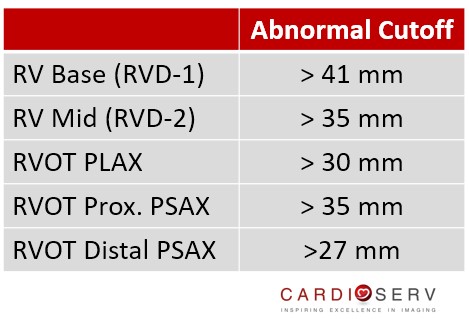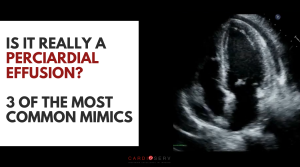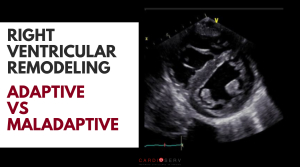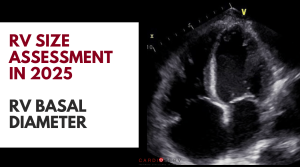Last Updated on January 30, 2024 by Hannes van der Merwe
We recently reviewed basic right heart anatomy and outlined the ASE updated recommendations for quantifying right heart size and function. For the 2nd part of our Right Heart blog series, we are going to discuss proper measurements for size evaluation of the right ventricle (RV).
IMAGING WINDOW
The ASE suggests measuring the RV size in the RV Focused AP4 view. Remember, the right ventricle is a ‘crescent shaped structure that hugs the left ventricle, which is why we must strive to obtain as many views as possible to fully examine the size & structure. The RV Focused AP4 view is the specific RV view that allows the full visualization of the maximum diameter of the RV.
RV Focused AP4:
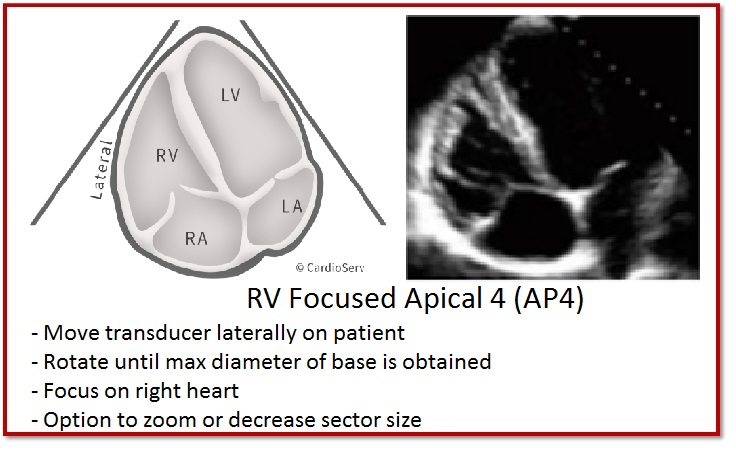
RV SIZE MEASUREMENT
The ASE explained two methods for measuring the size of the RV:
- Linear Measurements (2D)
- Volumetric Measurements (3DE)
ASE recommended method is via linear measurements over volumetric due to lack of advanced education in laboratories with 3DE.
- More reproducible
- Wealth of published data
HOW TO PERFORM CORRECT RV DIMENSIONS
- RV Focused Apical 4 view
- End-Diastole at widest width
- Parallel to TV annulus
- Inner-edge to inner-edge (I-I)
- RV Base (RVD1)
- Basal 1/3 of RV
- RV Mid (RVD2)
- Middle 1/3 of RV at level of Papillary Muscles
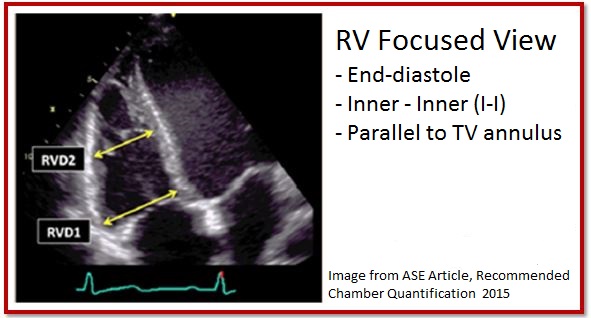
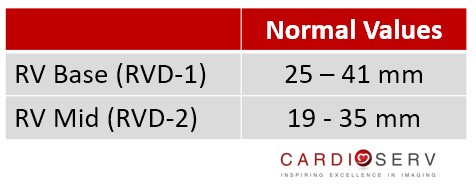
HOW TO PERFORM CORRECT RV OUTFLOW DIMENSIONS:
- All RVOT measurements are performed in the parasternal window
- Inner-edge to inner-edge method
- End-Diastole
Proximal RVOT
The proximal RVOT can be measured in both the long and short axis parasternal windows.
- Parasternal Long (PLAX)
- Anterior RV wall to IVS
- Parasternal Short Axis (PSAX)
- Anterior RV wall to Aortic Valve (AO)
Distal RVOT
The distal RVOT is measured in the short axis parasternal window.
- Parasternal Short Axis (PSAX)
- Proximal to Pulmonic Valve (PV)
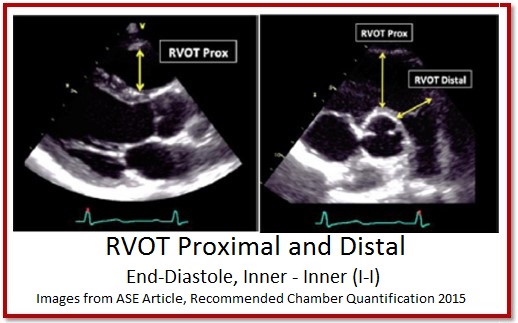
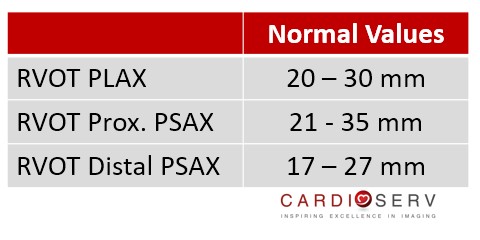
CHALLENGES/LIMITATIONS TO LINEAR MEASUREMENTS
- Complex geometry
- Lack of specific right-sided anatomic landmarks to use as reference points
- Easy to underestimate due to incorrect probe rotation
REFERENCE VALUES
ASE reference values for RV linear measurements are NOT based on BSA, gender or height. They have NOT been further classified into mild, moderate or severe.
Here is an easy reference chart to refer to in your scanning laboratory:
SUMMARY
The Intersocietal Accreditation Commission (IAC) requires all echo reports to comment on the size and function of the right ventricle. We often review studies with no quantitative assessment of the RV yet the physician is required to report on RV size! We appreciate the time constraints that sonographers face so start by adding at least one RV diameter measurement. Both the mid and basal RV diameter measurements (RVD1, RVD2) are routinely implemented within scanning laboratories and have a wealth of published data for dimension references.
7 TIPS TO IMPLEMENTING RV SIZE QUANTIFICATION
- We like the Basal RVD1 measurement as it represents the RV’s widest diameter (RVD2 is still acceptable)
- Standardize what measurements you use at your facility
- Remember to measure at end-diastole (largest RV size)
- Use the RV focused apical view
- Inner – to – Inner edge (I-I)
- If you cannot see it—do not measure it!
- Identify the RV diameter location on your final report. For example: Basal RV Diameter, Mid RV Diameter
- Remember, a patient may have a mid RV diameter reported and then receive a follow up echo at another facility that measures the basal RV diameter.
- Basal RV dimensions are larger than mid RV dimensions.
- We do not want to accidentally mislead a physician into thinking the RV size has increased when in reality it was just measured in a different location.
CONCLUSION
ASE recommends RV size quantification via linear measurements due to the wealth of published data for dimension references and its reproducibility. We reviewed the correct techniques and references ranges for measuring the right ventricle. If you are not currently measuring the RV as part of your routine study please start today! Join us in our mission to inspire excellence in imaging!
In the following weeks, we will discuss the proper methods for measuring the size of the RA and assessing the right ventricular function! We love your comments and questions so keep them coming and stay connected with us on Facebook, Twitter and LinkedIn.
WANT A CME FOR READING THIS BLOG? CLICK BELOW TO ACCESS CARDIOSERV’S ONLINE CME PLATFORM OFFERING CAT. 1 AMA CMES!


Andrea Fields MHA, RDCS, Clinical Cardiac Director
References
Lang, R. M., MD, Badano, L. P., MD, & Mor-Avi, V., PhD. (2015). Recommendations for Cardiac Chamber Quantification by Echocardiography in Adults: An Update from the American Society of Echocardiography and the European Association of Cardiovascular Imaging. JASE, 28(1), 1-53. Retrieved March 1, 2017, from http://asecho.org/wordpress/wp-content/uploads/2015/01/ChamberQuantification2015.pdf


